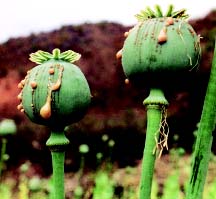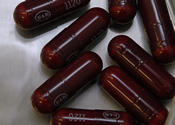Opiate Information
Opiates 
The term "opioid" refers to all drugs, natural or synthetic, with morphine-like properties. Both morphine and codeine are naturally occurring alkaloids derived from the seed pod of the opium poppy. Semi-synthetic opiates include heroin, a diacetyl derivative of morphine; hydromorphone, hydrocodone, and oxycodone derived by a simple modification of the morphine molecule. Synthetic opiates such as methadone and meperidine, mimic opiate effects but are not prepared from the poppy. The drugs may be administered by snorting, subcutaneous or intravenous injection, or smoking. Opioid compounds have analgesic and antitussive properties.
Years of research have shown us that addiction to any drug (illicit or prescribed) is a brain disease that, like other chronic diseases, can be treated effectively. No single type of treatment is appropriate for all individuals addicted to prescription drugs. Treatment must take into account the type of drug used and the needs of the individual. Successful treatment may need to incorporate several components, including detoxification, counseling, and in some cases, the use of pharmacological therapies. Multiple courses of treatment may be needed for the patient to make a full recovery.
The two main categories of drug addiction treatment are behavioral and pharmacological. Behavioral treatments encourage patients to stop drug use and teach them how to function without drugs, handle cravings, avoid drugs and situations that could lead to drug use, and handle a relapse should it occur. When delivered effectively, behavioral treatments-such as individual counseling, group or family counseling, contingency management, and cognitive behavioral therapies also can help patients improve their personal relationships and their ability to function at work and in the community.
Some addictions, such as opioid addiction, can be treated with medications. These pharmacological treatments counter the effects of the drug on the brain and behavior, and can be used to relieve withdrawal symptoms, treat an overdose, or help overcome drug cravings. Although a behavioral or pharmacological approach alone may be effective for treating drug addiction, research shows that, at least in the case of opioid addiction, a combination of both is most effective.
SUBOXONE is the first opioid medication approved under DATA 2000 for the treatment of opioid dependence in an office-based setting. SUBOXONE also can be dispensed for take-home use, just as any other medicine for other medical conditions.
The primary active ingredient in SUBOXONE is buprenorphine.
Because buprenorphine is a partial opioid agonist, its opioid effects are limited compared with those produced by full opioid agonists, such as oxycodone or heroin. SUBOXONE also contains naloxone, an opioid antagonist.
The naloxone in SUBOXONE is there to discourage people from dissolving the tablet and injecting it. When SUBOXONE is placed under the tongue, as directed, very little naloxone reaches the bloodstream, so what the patient feels are the effects of the buprenorphine. However, if naloxone is injected, it can cause a person dependent on a full opioid agonist to quickly go into withdrawal.
SUBOXONE at the appropriate dose may be used to:
- Reduce illicit opioid use
- Help patients stay in treatment
by
- Suppressing symptoms of opioid withdrawal
- Decreasing cravings for opioids
0piates are powerful drugs that have been used for centuries to relieve pain. These narcotic pain killers go by such names as OxyContin , Darvon, Vicodin,
, Darvon, Vicodin, Dilaudid, Demerol and Lomotil, and are often prescribed for post-operative pain. When used as directed by a physician, opiates are safe and generally do not produce addiction. But opiates also possess very strong reinforcing properties and can quickly trigger addiction when used improperly.
Dilaudid, Demerol and Lomotil, and are often prescribed for post-operative pain. When used as directed by a physician, opiates are safe and generally do not produce addiction. But opiates also possess very strong reinforcing properties and can quickly trigger addiction when used improperly.
Opiates act directly on the respiratory center in the brainstem, slowing down a person’s breathing. Excessive amounts of an opiate can cause the respiratory centers to shut down breathing altogether, causing death. Using needles to inject the opiates can also increase the risk of transmitting infectious diseases like HIV when abusers use unsterile or shared needles.
to inject the opiates can also increase the risk of transmitting infectious diseases like HIV when abusers use unsterile or shared needles.
There is a high risk of overdose with non-medically supervised use of opiates. Most recently, emergency room physicians discovered that new “slow release” versions of the drug have led abusers to crush the pills and inject or inhale the powder, creating a much higher risk of overdose.
- In 2012, the specific illicit drug category with the largest number of recent initiates among persons aged 12 or older was marijuana use (2.4 million), followed by nonmedical use of pain relievers (1.9 million), then nonmedical use of tranquilizers (1.4 million), followed by Ecstasy use (0.9 million), then use of stimulants, cocaine, and inhalants (0.6 million to 0.7 million)
Past Year Initiates for Specific Illicit Drugs among Persons Aged 12 or Older: 2012

"Past Year Initiates of Specific Illicit Drugs among Persons Aged 12 or Older: 2012." It is a bar graph, where the specific illicit drugs (marijuana, pain relievers, tranquilizers, Ecstasy, stimulants, cocaine, inhalants, LSD, sedatives, heroin, and PCP) are shown on the horizontal axis and the numbers in thousands of past year initiates are shown on the vertical axis. There is a note at the bottom of the figure that says, "Numbers refer to persons who used a specific drug for the first time in the past year, regardless of whether initiation of other drug use occurred prior to the past year."